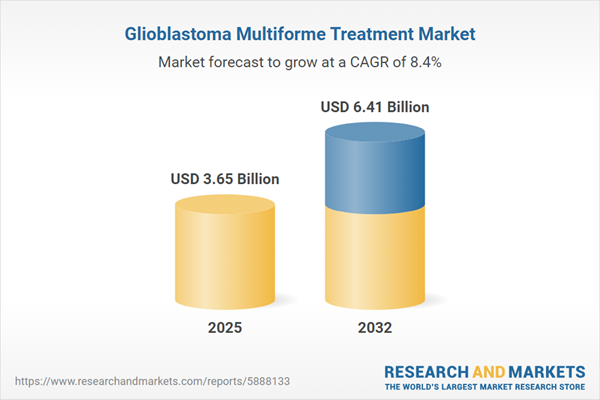Speak directly to the analyst to clarify any post sales queries you may have.
Senior executives face a complex and dynamic landscape in the glioblastoma multiforme treatment market, where innovations in precision medicine, increased digitalization, and evolving care models are reshaping decision-making for enterprise leaders.
Market Snapshot: Glioblastoma Multiforme Treatment Market
The global glioblastoma multiforme treatment market demonstrates strong growth, fueled by sustained investments and pivotal advances in precision medicine. Breakthroughs in gene-based therapies and the emergence of advanced immunotherapy platforms are altering clinical standards and drawing significant engagement from pharmaceutical firms, regulators, and research organizations. Collaboration across the sector is intensifying, resulting in a stricter regulatory environment that is raising quality thresholds and compelling operational shifts. Notably, the increasing adoption of digital health solutions and access to new clinical data streams are prompting organizations to formalize processes and leverage evolving digital capabilities within neuro-oncology care.
Scope & Segmentation of the Glioblastoma Multiforme Treatment Market
- Treatment Types: Chemotherapy, gene-editing therapies, oncolytic viruses, checkpoint inhibitors, vaccine-based immunotherapies, EGFR inhibitors, monoclonal antibodies focused on angiogenesis, advanced radiotherapy technologies, surgical interventions, and coordinated supportive care collectively target the complexity of glioblastoma multiforme through multidisciplinary strategies and technology-driven approaches.
- Drug Classes: Alkylating agents, checkpoint inhibitors, monoclonal antibodies, oncolytic viruses, dendritic cell vaccines, and peptide vaccines are integral to diverse treatment regimens, promoting personalization and stage-appropriate interventions.
- Line of Therapy: First-, second-, and third-line therapies are available, supporting precise treatment sequencing and responsive care as disease progresses.
- End User: Hospitals, specialty clinics, research institutions, and home healthcare providers play essential roles in clinical care, research, and disease management for patients with glioblastoma multiforme.
- Distribution Channels: Hospital and retail pharmacies, alongside digital health platforms, improve therapy access, patient adherence, and enable more coordinated neuro-oncology care services.
- Regions Covered: The Americas, Europe, Middle East, Africa, and Asia-Pacific—including China, India, Japan, Australia, South Korea, and Southeast Asia—offer distinct regulatory frameworks and commercial drivers, fostering unique regional strategies and collaborative approaches.
- Key Companies Profiled: F. Hoffmann-La Roche Ltd, Merck & Co., Inc., Novocure Ltd., Teva Pharmaceutical Industries Limited, Viatris Inc., Sandoz International GmbH, Dr. Reddy's Laboratories Limited, Accord Healthcare Limited, Zydus Lifesciences Limited, and Sun Pharmaceutical Industries Limited are advancing clinical development through research alliances and advanced technology integration.
Key Takeaways for Decision-Makers
- The convergence of traditional cytotoxic agents with gene-editing and immunotherapy platforms is driving new standards in personalized neuro-oncology care.
- Expansion of real-world evidence programs is reshaping clinical research and informs adaptive regulatory practices, supporting better alignment with patient needs.
- Strategic collaborations customized to specific regional dynamics enable efficient market entry and operational success across diverse regulatory settings.
- Innovative imaging and biomarker technologies are improving diagnosis speed and clinical outcome monitoring for advanced patient cohorts.
- Implementation of digital health systems is extending therapy reach, optimizing medication regimens, and addressing critical challenges in healthcare infrastructure.
Tariff Impact on Supply Chains and Market Access
Recent adjustments in U.S. tariff regulations for pharmaceuticals and biologics impact supply chain planning and cost dynamics in the glioblastoma multiforme treatment market. Organizations are responding through stronger diversification of sourcing, consolidation of domestic supplier partnerships, and operational resource reallocation to safeguard research standards and ensure uninterrupted patient access under shifting trade conditions.
Glioblastoma Multiforme Treatment Market Methodology & Data Sources
This analysis is grounded in a systematic review of scientific publications, regulatory submissions, company information, and real-time clinical trial data. Verification is reinforced by direct feedback from clinicians, policy experts, and supply chain leaders to maintain actionable industry relevance and robust market accuracy.
Why This Report Matters
- Enables clear insight into market segmentation and regional regulatory variations to support informed strategic planning and business growth for neuro-oncology stakeholders.
- Offers models for developing resilient supply chains and engaging effectively with payer organizations to optimize neuro-oncology market access.
- Equips senior leadership to anticipate new therapy adoption, proactively address risks, and sustain organizational agility in a complex global market.
Conclusion
Combining innovation and partnership, industry leaders are positioned to shape the evolution of glioblastoma multiforme treatment. Leveraging current intelligence enables improved care standards, strengthened agility, and effective market navigation.
Additional Product Information:
- Purchase of this report includes 1 year online access with quarterly updates.
- This report can be updated on request. Please contact our Customer Experience team using the Ask a Question widget on our website.
Table of Contents
3. Executive Summary
4. Market Overview
7. Cumulative Impact of Artificial Intelligence 2025
Companies Mentioned
The companies profiled in this Glioblastoma Multiforme Treatment market report include:- F. Hoffmann-La Roche Ltd
- Merck & Co., Inc.
- Novocure Ltd.
- Teva Pharmaceutical Industries Limited
- Viatris Inc.
- Sandoz International GmbH
- Dr. Reddy's Laboratories Limited
- Accord Healthcare Limited
- Zydus Lifesciences Limited
- Sun Pharmaceutical Industries Limited
Table Information
| Report Attribute | Details |
|---|---|
| No. of Pages | 189 |
| Published | November 2025 |
| Forecast Period | 2025 - 2032 |
| Estimated Market Value ( USD | $ 3.65 Billion |
| Forecasted Market Value ( USD | $ 6.41 Billion |
| Compound Annual Growth Rate | 8.3% |
| Regions Covered | Global |
| No. of Companies Mentioned | 11 |









